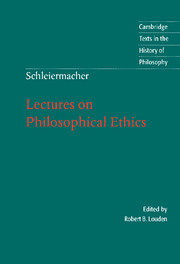Translator's note
Published online by Cambridge University Press: 05 June 2012
Summary
Schleiermacher builds up the very dense texture of the Philosophical Ethics by creating patterns and oppositions out of a limited number of key terms. One central pairing is the opposition between bilden and erkennen (later replaced by bezeichnen). Both these terms are problematic for the translator, particularly bilden, the primary sense of which is to form: it is necessary to translate bilden and its cognates with terms such as form, formative, formation, but it should always be borne in mind that the important secondary sense of educate/education can never be far from the reader's mind. The related term anbilden, which Schleiermacher uses in the sense of form onto or form further, has been rendered with the less syntactically awkward inculcate. The noun and adjective formed from erkennen, Erkenntnis, and erkennend, can readily be translated cognition and cognitive, but to render the verb as cognate is rarely appropriate in the context, so it appears in this translation as recognize.
A further opposition which creates some difficulties for the translator is that between Organ (organ) and Symbol (symbol). Schleiermacher extends their meaning into the verbs organisieren and symbolisieren, whose primary sense is organize and symbolize, but it is important to realize that they also carry the meaning turn into an organ and turn into a symbol.
- Type
- Chapter
- Information
- Schleiermacher: Lectures on Philosophical Ethics , pp. xxxix - xlPublisher: Cambridge University PressPrint publication year: 2002



